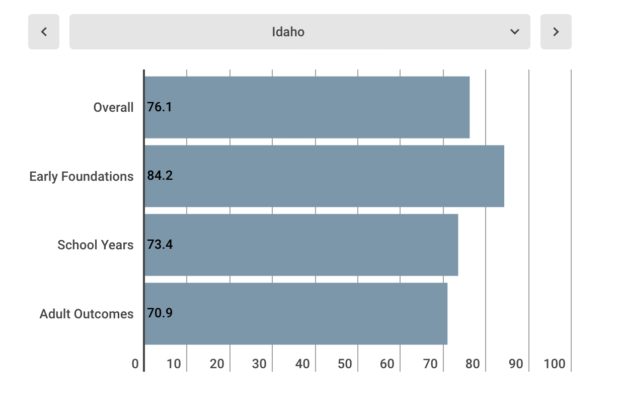
Idaho ranks near the bottom of the pack when it comes to children’s “chance for success,” according to an annual state-by-state review of educational opportunities and performance.
The study, conducted every year by education news outlet EdWeek, measures how states stack up on 13 metrics that “play into a student’s prospects for positive outcomes.”
Those measures include school performance — things like student proficiency in elementary reading and middle school math — but they also take into account familial factors like household income, and statewide metrics like the percent of adults with steady employment.
Idaho earned a C score on the 2020 review, ranking 39th of all 50 states and Washington D.C.
The average state scored a C-plus.
Nationwide, EdWeek found that opportunities for children tend to decline as they age.
“Young children generally start off with fairly strong foundations,” the study found, but “opportunities decline as they progress through the educational pipeline.”
This appears especially true in Idaho.

In national rankings, Idaho comes in at 30th place for “early foundations” — like how many children live above a certain income threshold and have at least one parent working full time. The state falls to 40th in the nation when it comes to “school years” measures, including student’s grasp of reading in the 4th grade and high school graduation.
But Idaho’s worst ranking is when it comes to the outlook for adults. Here, the state is ranked 44th in the nation across measures including percent of adults in the labor-force full time and percent of adults with a post secondary degree.
Idaho’s overall ranking has slipped in the past decade. In 2010, a measure of the same indicators ranked the state 32nd in the nation.
However, while Idaho might not be performing well stacked up against other states, it has improved in most categories since the 2010 survey was published.
For example, the percent of children living in households that make at least 200 percent of the federal poverty threshold has increased by about 3 percent in the last decade. High school graduation increased to nearly 80 percent, up from 76 percent.
And the outlooks for adults has improved, too. In 2010, some 35 percent of Idaho’s adults had a two or four-year degree, the study reported.
This year, that was up to 38 percent.
For a listing of how Idaho performed on all 13 metrics, click here.
